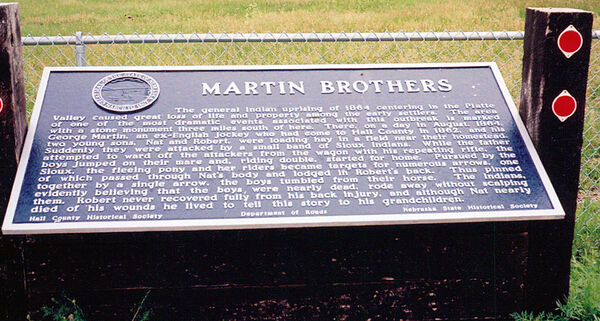Difference between revisions of "Nebraska Historical Marker: Martin Brothers"
m |
|||
| Line 3: | Line 3: | ||
==Location== | ==Location== | ||
Historical Marker 32 near Exit 305 interchange visitor center south of I-80 on 40C, Hall County, Nebraska | Historical Marker 32 near Exit 305 interchange visitor center south of I-80 on 40C, Hall County, Nebraska | ||
| + | |||
View this marker's location '''[https://maps.google.com/maps?q=40.79653,+-98.492595&hl=en&ll=40.79682,-98.491917&spn=0.007139,0.016512&sll=40.796528,-98.492571&sspn=0.007139,0.016512&t=h&gl=us&z=17 40.79653, -98.492595]''' | View this marker's location '''[https://maps.google.com/maps?q=40.79653,+-98.492595&hl=en&ll=40.79682,-98.491917&spn=0.007139,0.016512&sll=40.796528,-98.492571&sspn=0.007139,0.016512&t=h&gl=us&z=17 40.79653, -98.492595]''' | ||
| + | |||
View a map of all Nebraska historical markers, '''[http://www.nebraskahistory.org/publish/markers/texts/index.shtml Browse Historical Marker Map]''' | View a map of all Nebraska historical markers, '''[http://www.nebraskahistory.org/publish/markers/texts/index.shtml Browse Historical Marker Map]''' | ||
Revision as of 08:36, 17 March 2017
Location
Historical Marker 32 near Exit 305 interchange visitor center south of I-80 on 40C, Hall County, Nebraska
View this marker's location 40.79653, -98.492595
View a map of all Nebraska historical markers, Browse Historical Marker Map
Marker Text
The general Indian uprising of 1864 centering in the Platte Valley caused great loss of life and property among the early settlers. The area of one of the most dramatic events associated with this outbreak is marked with a stone monument three miles south of here. There, on a day in August, 1864, George Martin, an ex-English jockey who had come to Hall County in 1862, and his two young sons, Nat and Robert, were loading hay in a field near their homestead. Suddenly they were attacked by a small band of Sioux Indians. While the father attempted to ward off the attackers from the wagon with his repeating rifle, the boys jumped on their mare and, riding double, started for home. Pursued by the Sioux, the fleeing pony and her riders became targets for numerous arrows, one of which passed through Nat's body and lodged in Robert's back. Thus pinned together by a single arrow, the boys tumbled from their horse. The Indians, evidently believing that the boys were nearly dead, rode away without scalping them. Robert never recovered fully from his back injury, and although Nat nearly died of his wounds he lived to tell this story to his grandchildren.
Further Information
Bibliography
Marker program
See the Nebraska Historical Marker Program for more information.
